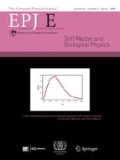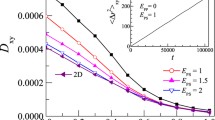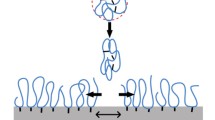Abstract:
Compression of an adsorbed polymer layer distorts its relaxed structure. Surface force measurements from different laboratories show that the return to this relaxed structure after the compression is released can require tens of minutes and that the recovery time can grow rapidly with molecular weight. We argue that the arrested state of the free layer before relaxation can be described as a Guiselin brush structure (O. Guiselin, Europhys. Lett. 17, 225 (1992)), in which the monomer density falls off only weakly with distance from the surface. This brush structure predicts an exponential falloff of the force at large distance with a decay length that varies as the initial compression distance to the 6/5 power. This exponential falloff is consistent with surface force measurements. We propose a relaxation mechanism that accounts for the increase in relaxation time with chain length.
Similar content being viewed by others
Author information
Authors and Affiliations
Additional information
Received 15 January 2002 and Received in final form 5 September 2002
Rights and permissions
About this article
Cite this article
Raviv, U., Klein, J. & Witten, T. The polymer mat: Arrested rebound of a compressed polymer layer. Eur. Phys. J. E 9 (Suppl 1), 405–412 (2002). https://doi.org/10.1140/epje/i2002-10053-9
Issue Date:
DOI: https://doi.org/10.1140/epje/i2002-10053-9




